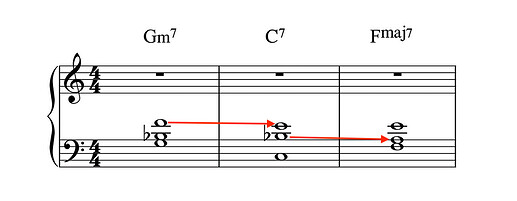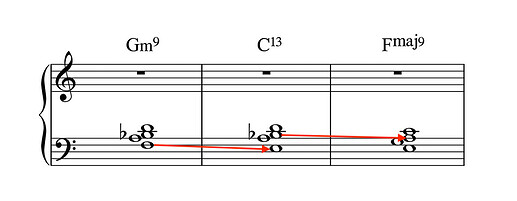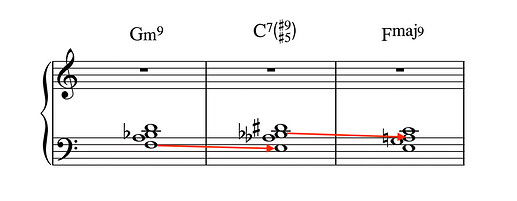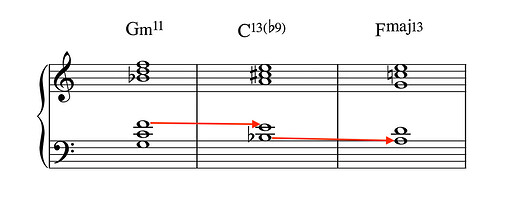Here is the recommended sequence to progress through PianoGroove’s Beginner Lessons.
Once you have worked through the beginner material you can check out the contents of our more advanced learning syllabuses:
Course Syllabus 1: The Basic Syllabus
Below we outline the beginner jazz courses in the order they should be taken. We start by highlighting the beginner jazz standard tutorials, starting with the easiest and working onto more challenging arrangements.
If you have any questions relating to these courses and lessons, simply reply to this thread and we will be happy to assist you.
8 Beginner Jazz Standards
It’s very important that you are working on both the theory lessons and the jazz standard lessons together. Broadly split your practice time in half. Start with theory lessons and drills and then move onto the jazz standards.
The jazz standards are the vehicle you use to apply the theory. When you apply the theory in context of a jazz standard, it will make much more sense and you will retain the information much better than just from theory drills.
You can be working on 3 or more jazz standards at the same time. Perhaps pick a new tune every few weeks or every month. And gradually build out your repertoire.
The beginner jazz standards should be approached in the following order:
Jazz Standard 1: Tune Up
Jazz Standard 2: Misty
Jazz Standard 3: Tenderly
Jazz Standard 4: My Foolish Heart
Jazz Standard 5: Over The Rainbow
Jazz Standard 6: In A Sentimental Mood
Jazz Standard 7: My Funny Valentine
Jazz Standard 8: Beautiful Love
When playing jazz standards, make sure you are analysing each chord you play in terms of scale degrees. Look at the individual notes and say ’that’s the root, that’s the major 3rd, that’s the 9th etc…’ this is important.
Now Onto The 3 Beginner Jazz Courses:
Course 1: Jazz Piano Foundations:
If you’re new to jazz piano… start here!
The foundation course covers the essential theory to start your jazz piano journey. It’s important that you understand the theoretical underpinnings of these lessons, and then you can move on. Much of what is included in this course will take years to fully master. Watch the lessons, takeaway the key points to remember, and then move on.
Here’s some additional guidance for the Jazz Piano Foundations course:
-
Major scales are the foundation for everything. In jazz we learn them numerically, so instead of thinking of note names (C-D-E-F-G-A-B) we think in numbers (1-2-3-4-5-6-7). Thinking numerically makes every key equal and it will make your life a million times easier when you progress onto more complicated topics. Learn the Major Scales first, and then move onto the 3 minor scales.
-
The lesson on Intervals is mainly to introduce you to the interval names. We use these names throughout the PianoGroove course and so you will gradually become familiar with them all.
-
In the lessons on triads and 7th chords, I talk about practicing inversions. This doesn’t happen overnight so don’t get caught up on that. Every time you play through a jazz standard you will be revisiting this information, and so becoming familiar with all of these voicings is a gradual process.
-
The 251 is the most common progression in jazz music. The first step is the Major 251 Progression (both type A and type B) using 3 note voicings. Remember to look out for these in the jazz standard lessons. You need to be able to identify this common progression.
-
A very important lesson in this series is the lesson “How To Read Lead Sheets” - this highlights the fundamental skills of arranging from a lead sheet when playing solo jazz piano.
Course 2: Extended Chords & Voicings
This course introduces the concept of chord extensions. We cover some common extended voicings and apply them to 4 famous jazz standards (Misty, Tenderly, My Foolish Heart & Over The Rainbow)
It’s very important to memorise the scale degree at the top of voicings , for example:
-
The top note of the So What Voicing is the 5th and so on a lead sheet, whenever you come across a minor chord (in any key) with the 5th in the melody, the So What Voicing will sound great.
-
The Kenny Barron Voicing has the 11th on the top so this is a great minor voicing when the 11th is in the melody.
-
The Herbie Hancock Voicing has the 9th in the melody so this will be a good choice of voicing when you come across the 9th in the melody over a minor chord.
When learning these voicings, always think in terms of numbers (i.e. scale degrees) rather than certain notes. This will help you internalise the voicings.
By ‘internalise’ I mean remember the formula. With jazz it is far more efficient to think in terms of numbers (or scale degrees) than to think of individual notes.
For example, with the So What Chord, from top to bottom, it contains the Root. 11th, b7th, b3rd and 5th. Knowing this formula means you can then apply it to any key… considering you know your major and minor scales!
Course 3: Rootless Voicings & The Minor 251
Rootless Voicings & The Major 251
Rootless Voicings are an important area to work on. The first step is to understand their construction, and then you can combine the chords into the Rootless 251 Progression
This progression take time to get down in all 12 keys and so don’t be disheartened with slow process. It’s best to practice rootless voicings in context of 251s.
Leaving the root out of the chord has a number of key benefits:
-
You free up a finger for a more interesting note choice such as an extension or alteration
-
Rootless voicings voice lead much more smoothly in a 251- it’s easy to play a rootless 251 without looking and so you can focus on your right hand lines and improvisation.
-
It gets you familiar with extensions and alterations, if you don’t practice rootless voicings, chances are you will be sticking to simple root position 7th chords. Practicing rootless voicings will give you a much greater appreciation of the extended and altered tones available to you.
Rootless voicings can often be a hard area to grasp for students coming from a classical background, read this in-depth explanation here:
The Minor 251 Progression:
The next step is to learn and master the minor 251 progression. Minor harmony is much more challenging that major harmony and you will likely find this difficult to begin with. The Minor 251 uses chord alterations over the V7alt chord which adds a new dimension to your sound.
The final important theory area in this course is the Minor Line Cliche. This descending or ascending voice movement is extremely common in jazz standards. It’s important to be able to recognise this progression and its various guises.
A key point with all of these progressions is to practice them in context of jazz standards. The jazz standards in this course - In A Sentimental Mood, My Funny Valentine, & Beautiful Love - have been carefully selected to demonstarte and apply the theoretical aspects of the course.









 lol)
lol)






